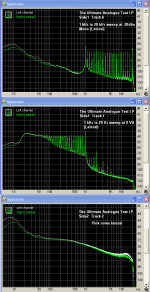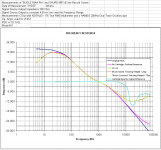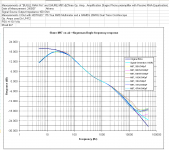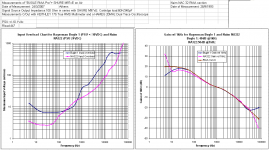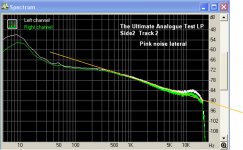I realised today that I don't have any frequency sweep records I can trust. Not only that but a lot of people use a pink noise track to measure FR, but the details of the pink noise is never given. Before this raises too many eyebrows as 'pink' has a specific 3db/octave roll off by definition there are high and low frequency issues with vinyl cutting that may mean this is not the case, and enough FFTs I have seen published give a slope I would not normally expect. So whilst I may be wrong I feel there is a need to calibrate so we know.
Question is how? Or has some kind soul already done this and I have not come across the measurements?
Question is how? Or has some kind soul already done this and I have not come across the measurements?
I have some old CBS Labs calibration records that do sweeps and all kinds of tests. I have 4 or 5 records. Not everything is on one record. I would check eBay or some of the vinyl sites. I purchased them from an electronics repair business that was closing. I believe they were popular back in the hey day of vinyl.
Off the top of my head, I can't recall if they have pink noise.
Off the top of my head, I can't recall if they have pink noise.
I also have, and have had, several test discs. And I do not remember pink noise on them.
The sweeps will help you, tho the older LPs I have only sweep 30-10,000 Hz. Some of the newer ones do more, IIRC.
The sweeps will help you, tho the older LPs I have only sweep 30-10,000 Hz. Some of the newer ones do more, IIRC.
I have the full set of RCA STR records, I think they were made as carefully as they could at the time. There is an AES paper on the first one, STR-101 with details. The FR plots on the sweeps seemed OK, the 1/3rd octave pink noise has problems with mis-tracking at higher frequencies. You can find the track listings on the web, there were quite a few pink noise tracks. If you found it compelling I would lend you one for postage. The ebay prices can be stupid.
Last edited:
I should note I don't necessarily want to use pink noise, but I'm hunting around trying to find a decent new record with a sweep. The old records which could be picked up cheap 30 years ago are as Scott says silly money now. The hifinews record has a sweep but as an afterthough on the last track.
I'll try sampling my cardas record and see what the fft looks like.
I'll try sampling my cardas record and see what the fft looks like.
Bill check this one
Analogue Productions-The Ultimate Analogue Test LP-Turntable Set Up Tools|Acoustic Sounds
George
Analogue Productions-The Ultimate Analogue Test LP-Turntable Set Up Tools|Acoustic Sounds
George
Attachments
I saw that, but was put off because the track listings are twice on that page and different so not clear if the sweeps are full range of just LF.
EDIT: careful re-read and it has 1kHz to 20Khz, but no mono 10-1000 sweep. So half useful.
EDIT: careful re-read and it has 1kHz to 20Khz, but no mono 10-1000 sweep. So half useful.
Last edited:
Bill
Side 1 Track 6 is the HF sweep
Track 6 1000Hz to 20000Hz sweep at -20dbu, Mono (Lateral)
Side 1 Track 7 is the LF sweep
Track 7 1000Hz to 20 Hz sweep at 0 VU (Lateral)
The FFTs are from this test LP using my TD160 MKII / SME3009 Improved / Denon DL-103, all modified)
George
Side 1 Track 6 is the HF sweep
Track 6 1000Hz to 20000Hz sweep at -20dbu, Mono (Lateral)
Side 1 Track 7 is the LF sweep
Track 7 1000Hz to 20 Hz sweep at 0 VU (Lateral)
The FFTs are from this test LP using my TD160 MKII / SME3009 Improved / Denon DL-103, all modified)
George
For the cost of that record having a 20dB difference between LF and HF seems a bit of a drag. your attachments don't zoom up very much but is there 6dB level difference between 1Khz and he rest of the sweep?
Also the pink noise doesn't look pink, do you know what that is?
Also the pink noise doesn't look pink, do you know what that is?
Bill
I thought you would have understood it. I only show what the tracks are for your convenience.
I am not promoting that LP
Track 6 and track 7 are two different tracks with different signal levels for a reason.
But each track has the 1KHz tone as it’s local level reference.
When using a voltmeter or an oscilloscope at the output of a RIAA preamplifier, the 1KHz on each track reads the same amplitude as it’s neighbor frequencies, but the length of the 1KHz recording is longer (for giving time to set the metering device), therefore due to this longer time, the 1KHz FFT peak is higher than the rest of the frequencies.
For the same reason, on track 6 the 20KHz FFT peak is higher than the rest of the HF peaks.
The content of all test LPs were not meant to be monitored through an FFT but either through ear, voltmeter or an oscilloscope (and for resonance test tracks through naked eye).
George
I thought you would have understood it. I only show what the tracks are for your convenience.
I am not promoting that LP
Track 6 and track 7 are two different tracks with different signal levels for a reason.
But each track has the 1KHz tone as it’s local level reference.
When using a voltmeter or an oscilloscope at the output of a RIAA preamplifier, the 1KHz on each track reads the same amplitude as it’s neighbor frequencies, but the length of the 1KHz recording is longer (for giving time to set the metering device), therefore due to this longer time, the 1KHz FFT peak is higher than the rest of the frequencies.
For the same reason, on track 6 the 20KHz FFT peak is higher than the rest of the HF peaks.
The content of all test LPs were not meant to be monitored through an FFT but either through ear, voltmeter or an oscilloscope (and for resonance test tracks through naked eye).
George
Ah sorry, the track listing doesn't say that the 1Khz tone is longer on track 7 and I assumed levelsetting was done with track 6. My bad.
I have "Audio Obstacle Course", the "Stereo Review" test LP and "Ultimate Analog" -- just about 3 weeks ago I used Ultimate Analog with FFT to adjust a Shure cart on the SL-1200
Bill
If your needs are only for accurate frequency response testing, the purchase of a test record is not the only (nor the best IMO) choise
By wiring in series to the RIAA preamplifier the cartridge and a signal generator of low Ro (*) and of mV output, you can have freq response measurements far more precise that you can achieve with the best test LP.
Of course you don’t test the effects of the mechanical parts of the cartridge (tip, cantilever), only the generator.
Effect of interconnects, R, C cartridge loading, RIAA eq accuracy, preamplifier overload behavior, you can test all these.
You can even study the electrical resonance of the cartridge by measuring the voltage drop across the coil.
(*) If you make a low Ro buffer, you can use your soundcard with an applicable SW on the PC as the generator and do all kind of checks (spot freq checks, sinusoidal log sweeps, pink, white noise excitation ect).
George
If your needs are only for accurate frequency response testing, the purchase of a test record is not the only (nor the best IMO) choise
By wiring in series to the RIAA preamplifier the cartridge and a signal generator of low Ro (*) and of mV output, you can have freq response measurements far more precise that you can achieve with the best test LP.
Of course you don’t test the effects of the mechanical parts of the cartridge (tip, cantilever), only the generator.
Effect of interconnects, R, C cartridge loading, RIAA eq accuracy, preamplifier overload behavior, you can test all these.
You can even study the electrical resonance of the cartridge by measuring the voltage drop across the coil.
(*) If you make a low Ro buffer, you can use your soundcard with an applicable SW on the PC as the generator and do all kind of checks (spot freq checks, sinusoidal log sweeps, pink, white noise excitation ect).
George
Attachments
George: This is for overall system response, mechanical resonances and all, although happy to look at the different techniques people use for measuring the electrical response as I do want to measure all that as well.
I hope to get to the state where I can produce graphs like yours! 5.2 children suggests this may take me a while tho 😀
I hope to get to the state where I can produce graphs like yours! 5.2 children suggests this may take me a while tho 😀
Yes, I find it useful and also use the 3140Hz test track for checking speed stability and wow with Platterspeed. (Just an occasional check to make sure my two tables are up to snuff.)
I do purely electrical measurements when designing phono stages using a couple of inverse RIAA networks, the best one I have is commercial (gift from former employer) and is better than +/- 0.1dB..
I have done a few frequency response sweeps in the past and even with phono stages that comply to RIAA within a +/-0.2dB window or better I can see plenty of deviation due to the cartridge and probably to some extent cutter performance as well. If the combined error is less that 1.5dB that would be excellent IMVLE.
I do purely electrical measurements when designing phono stages using a couple of inverse RIAA networks, the best one I have is commercial (gift from former employer) and is better than +/- 0.1dB..
I have done a few frequency response sweeps in the past and even with phono stages that comply to RIAA within a +/-0.2dB window or better I can see plenty of deviation due to the cartridge and probably to some extent cutter performance as well. If the combined error is less that 1.5dB that would be excellent IMVLE.
If the combined error is less that 1.5dB that would be excellent IMVLE.
Perhaps then the digital correction should encompass more?
- Status
- Not open for further replies.
- Home
- Source & Line
- Analogue Source
- calibrating test records
